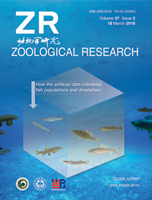
|
Zoological Research
Kunming Institute of Zoology, Chinese Academy of Sciences
ISSN: 2095-8137
Vol. 30, No. 5, 2009, pp. 527-533
|
 Bioline Code: zr09081
Bioline Code: zr09081
Full paper language: Chinese
Document type: Research Article
Document available free of charge
|
|
|
Zoological Research, Vol. 30, No. 5, 2009, pp. 527-533
| en |
Lesions to the Orbitofrontal Cortex Produce the Novelty-Seeking Behavior Deficits in Rats
Wang, Xiu-song; Fu, Yu; Ma, Man-xiu; Zhang, Jun-jun & Ma, Yuan-ye
Abstract
We examined the role of the orbitofrontal cortex (OFC) on exploration of the novel environment using the open-field and Y-maze behavioral paradigms to assess the novelty-seeking behavior of the male Sprague-Dawley rats after receiving bilateral electrolytic lesions of the OFC or sham lesions. In the open-field task, the rats with OFC lesions exhibited reduced average ambulation distance and average rearing number when compared with the animals with sham lesions. Moreover, rats with OFC lesions showed less duration of visits and number of entries in the novel arm in the Y-maze task than the control animals. The current findings suggest that the OFC plays an important role on the novelty-seeking behavior in rats.
Keywords
Orbitofrontal cortex; Electrolytic lesions; Novelty-seeking; Open-field; Y-maze; Rat
|
| |
© Copyright 2009 Kunming Institute of Zoology, the Chinese Academy of Sciences
Alternative site location: http://www.zoores.ac.cn/
|
|
